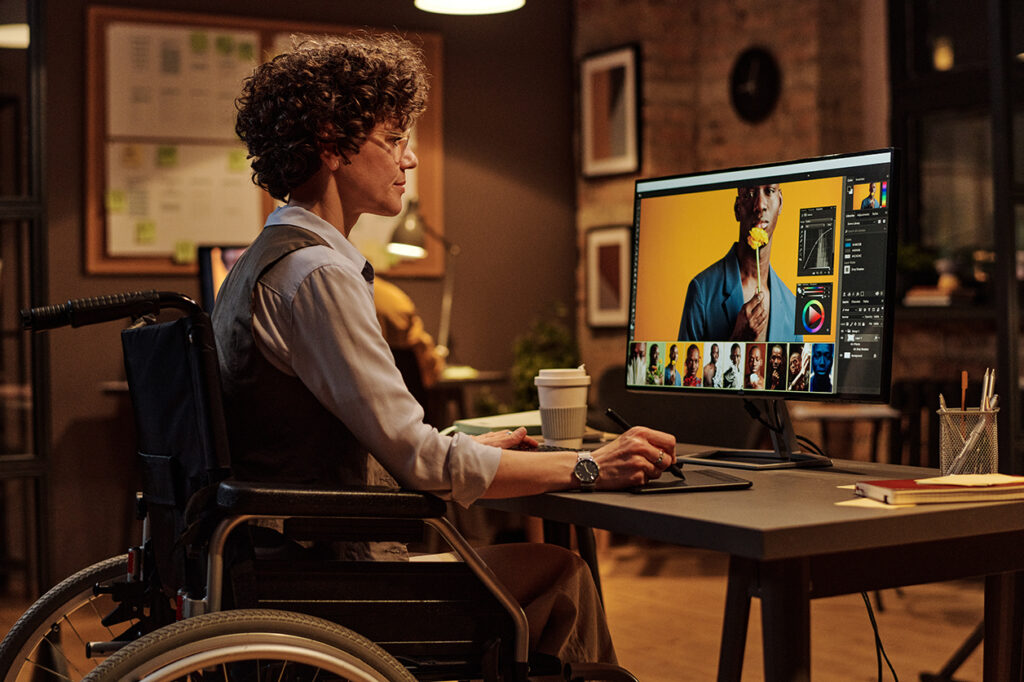At Top Shelf Design, we don’t just create beautiful, functional designs—we champion human-centered experiences that are inclusive, ethical, and meaningful.
From award-winning print materials to intuitive digital platforms, our work with nonprofits, associations, and public organizations reflects a commitment to clear communication, strategic clarity, and depth of impact (see our blog).
Accessibility is more than a checkbox or a legal requirement—it’s a design imperative. It’s about expanding your message’s reach, reflecting empathy, and honoring the diverse abilities of your audience. For one of our lead designers, Andrew, accessibility is also personal. Growing up with a mother living with multiple sclerosis, Andrew witnessed firsthand how design—good and bad—can either empower or exclude.
That experience inspired both his master’s thesis on accessible design and his ongoing work at Top Shelf, where accessibility isn’t just theory, but lived practice. As Andrew wrote in his research:
“Accessibility should not be treated as a checklist of requirements but as a framework for design thinking that places human dignity and usability at its core.”
Why Accessibility Goes Beyond Compliance
- Ethical Design as Mission Fulfillment
Your mission matters. Whether you’re advancing public policy, supporting communities, or telling powerful data stories, inclusive design ensures those messages resonate with everyone—regardless of ability. - Trustworthy, User-Centered Strategy
Just as we design dashboards to prioritize usefulness and clarity, structuring our work around accessibility fosters equitable access, and strengthens user trust and satisfaction. - Responsible Leadership by Example
Andrew’s research and personal perspective remind us that when accessibility is embraced as a design value—not an afterthought—organizations model equity and inclusion in powerful, lasting ways.
Accessibility Through the Lens of Good Design Practice
Accessibility doesn’t hinder creativity—it enriches it. Here’s how to weave inclusion into every layer:
- Visual Design
- Prioritize color contrast and legibility.
- Use scalable, clear typography.
- Build intuitive layouts with hierarchy and spacing.
- Interaction & Navigation
- Ensure keyboard navigability and visible focus states.
- Label forms clearly and include accessible controls.
- Alternative Media
- Provide meaningful alt text for images.
- Use semantic HTML and ARIA roles.
- Include captions or transcripts for multimedia assets.
- Responsive & Mobile-First Thinking
- Design adaptable layouts for all screen sizes and assistive technologies.
- Consider voice control, screen orientation, and device accessibility behaviors.
Embedding Accessibility into Your Process
To make accessibility actionable, integrate it into the design-to-delivery cycle:
- Discovery & Research
Identify the inclusive needs of your users early—interview, prototype, and gather feedback from diverse users. - Design & Prototyping
Use accessible color palettes, font sizes, and semantic components from the start—not as an afterthought. - Collaboration & Audit
Use automated auditing tools (Lighthouse, axe) in tandem with manual testing—screen readers, keyboard-only navigation, and functional reviews. - Iteration & Education
Teach teams how to sustain accessibility—provide style guide checklists, alt-text standards, and ARIA role protocols.
A Personal Thesis in Practice
Andrew’s graduate thesis explored how design systems can dismantle barriers for disabled populations, arguing that accessibility should not be treated as compliance but as an ethical responsibility.
Today, those ideas live inside every Top Shelf project. Whether designing for screen readers, creating accessible reports, or ensuring color contrast in branding, our process is informed by both rigorous study and lived experience.
In Closing: Accessibility is Ethical Design
At Top Shelf Design, our approach has always been rooted in clarity, human connection, and integrity across print and digital work. Incorporating accessibility is not an add-on—it’s central to creating impactful, inclusive design that truly serves everyone.
For Andrew, this isn’t just professional—it’s personal. And for us as a team, it’s proof that when we design inclusively, we design with purpose.
Let’s elevate your work through more equitable design experiences.
Ready to talk accessibility-infused strategy for your next project? Reach out to us.

